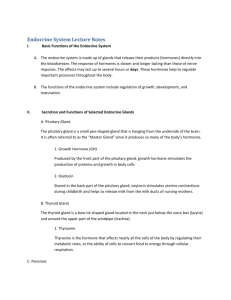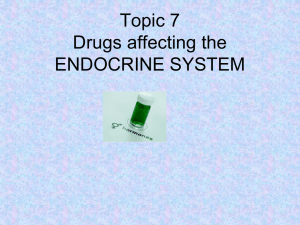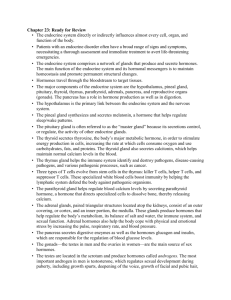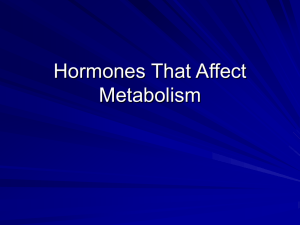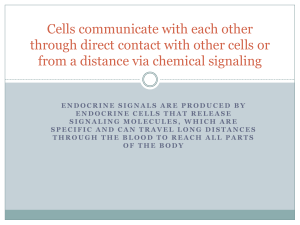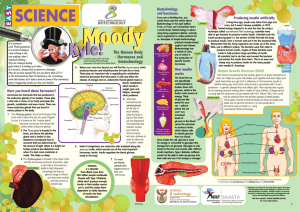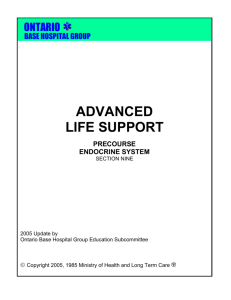Unit 4 Endocrine System
advertisement
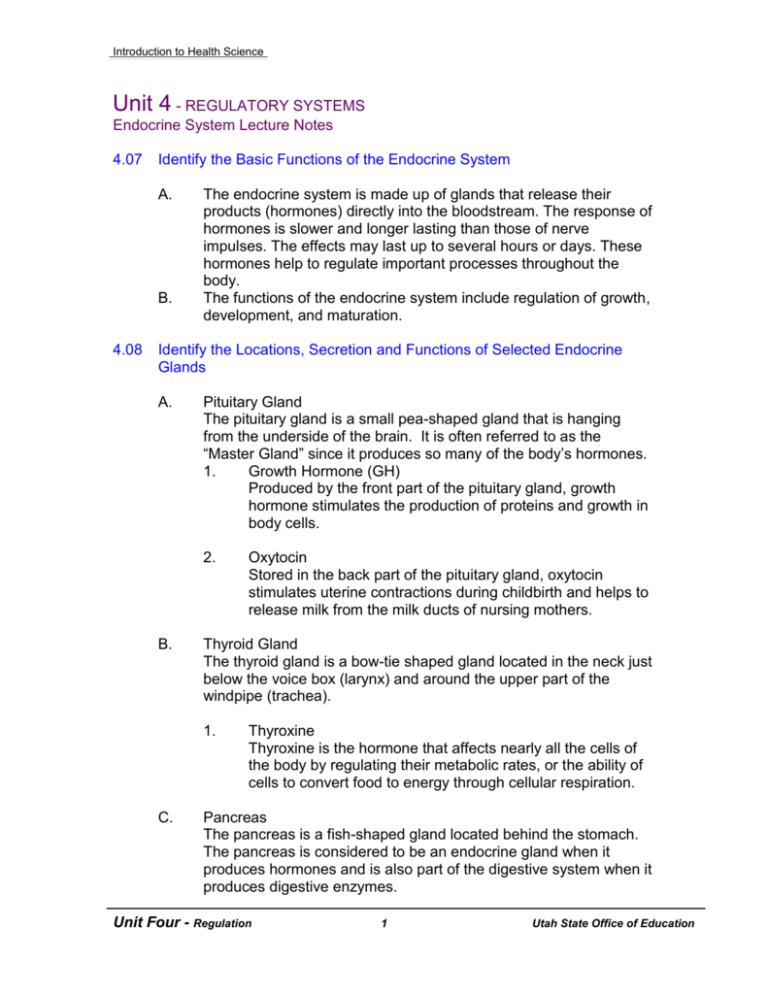
Introduction to Health Science Unit 4 - REGULATORY SYSTEMS Endocrine System Lecture Notes 4.07 Identify the Basic Functions of the Endocrine System A. B. 4.08 The endocrine system is made up of glands that release their products (hormones) directly into the bloodstream. The response of hormones is slower and longer lasting than those of nerve impulses. The effects may last up to several hours or days. These hormones help to regulate important processes throughout the body. The functions of the endocrine system include regulation of growth, development, and maturation. Identify the Locations, Secretion and Functions of Selected Endocrine Glands A. Pituitary Gland The pituitary gland is a small pea-shaped gland that is hanging from the underside of the brain. It is often referred to as the “Master Gland” since it produces so many of the body’s hormones. 1. Growth Hormone (GH) Produced by the front part of the pituitary gland, growth hormone stimulates the production of proteins and growth in body cells. 2. B. Thyroid Gland The thyroid gland is a bow-tie shaped gland located in the neck just below the voice box (larynx) and around the upper part of the windpipe (trachea). 1. C. Oxytocin Stored in the back part of the pituitary gland, oxytocin stimulates uterine contractions during childbirth and helps to release milk from the milk ducts of nursing mothers. Thyroxine Thyroxine is the hormone that affects nearly all the cells of the body by regulating their metabolic rates, or the ability of cells to convert food to energy through cellular respiration. Pancreas The pancreas is a fish-shaped gland located behind the stomach. The pancreas is considered to be an endocrine gland when it produces hormones and is also part of the digestive system when it produces digestive enzymes. Unit Four - Regulation 1 Utah State Office of Education Introduction to Health Science D. 1. Insulin Insulin is released when the blood sugar (glucose) is high. It helps the body cells to move glucose into the cells and helps the liver and muscle to convert glucose into glycogen. It also helps to convert excess glucose to fat which is then stored. 2. Glucagon Glucagon is released when the blood sugar (glucose) is low. It helps to break down the glycogen in the liver and the muscles into glucose. When this occurs, it then raises the blood glucose levels. Adrenal Glands The adrenal glands are two triangular-shaped glands that sit on top of each kidney. 1. Cortisol Cortisol helps to control the rate of metabolism of carbohydrates, fats, and proteins. It is known as the stress hormone and is released during times of continuous stress. While cortisol has many positive aspects, a negative aspect is that it suppresses the action of the white blood cells. This makes a person more susceptible to illness. 2. Adrenaline Adrenaline (epinephrine) makes up 80% of the secretions from the adrenal medulla. Along with noradrenaline, it helps to regulate the stress (sympathetic) response or the “fight or flight.” 3. Noradrenaline Noradrenaline (norepinephrine makes up 20% of the secretions from the adrenal medulla. Along with adrenaline, it helps to regulate the stress (sympathetic) response or the “fight or flight.” a. The Sympathetic Response • increased heart rate • increased breathing rate • increased blood flow to the muscles • increased blood pressure • increase in the depth of breathing increasing oxygen intake • release of extra glucose for more energy • sweaty hands and palms Unit Four - Regulation 2 Utah State Office of Education Introduction to Health Science 4.09 Describe Diseases and Disorders of the Endocrine System A. Diabetes Mellitus Type I Type I Diabetes Mellitus is a lifelong disease that occurs when the pancreas does not produce enough insulin to regulate blood sugar. Without insulin, the glucose increases in the bloodstream instead of going into the body cells where it can be used for energy. This leads to increased hunger. The cause is unknown though may be related to genetics or infections. 1. Symptoms of DM Type I include; increased thirst, increased hunger, increased urination, weight loss despite increased appetite, fatigue, nausea and vomiting. 2. Treatment includes administration of insulin to reduce and control blood glucose levels, modifications in diet, regular exercise, learning how to self-test glucose and administer insulin, learning proper foot care, learning the signs and treatment of hypoglycemia. 3. Possible complications include vascular disease, eye problems, kidney damage, nerve damage, foot problems, neuropathy, and infections. 4. Extremely important that a person learns how and why to control blood glucose levels. B. Diabetes Mellitus Type II Type II Diabetes Mellitus is a life-long disease marked by high levels of sugar in the blood that occurs when the body does not respond correctly to insulin. In other words, glucose cannot enter the body cells to be used in energy production. It is the most common form of diabetes. Risk factors include genetics, race, age, high blood pressure, high blood cholesterol, history of gestational diabetes, low activity level, poor diet, and excess body weight (especially around the waist). 1. Symptoms include increased thirst, increased hunger, increased urination, weight loss despite increased appetite, fatigue, and frequent or slow-healing infections. 2. Treatment includes exercise, diet, weight control, and control of blood sugar with medications (if needed). 3. Complications include eye disease, kidney disease, nerve damage, damage to blood vessels and circulation, atherosclerosis, and coronary artery disease. C. Gigantism Gigantism is due to a hypersecretion or overproduction of the growth hormone during childhood resulting in a person who grows to a very large size. May be caused by a non-cancerous tumor of the pituitary gland. Unit Four - Regulation 3 Utah State Office of Education Introduction to Health Science 1. Symptoms mainly include excessive growth during childhood but may also include delayed puberty, headaches, over development of body features. 2. Treatment may include surgery, medication or radiation to regulate the size of the tumor or production of growth hormone. D. Dwarfism Dwarfism is due to a hyposecretion or underproduction of the growth hormone during childhood resulting in a small person who has a body frame of normal proportions. May be present at birth or develop after birth as result of brain injury, tumor or medical condition. 1. Symptoms include child who is short in stature and/or experiences little to no growth. Children may also experience delayed or absence of puberty. 2. Treatments involves injections of growth hormone to stimulate growth as well as counseling to help the child cope with emotional challenges. E. Hypothyroidism Hypothyroidism occurs when the thyroid gland fails to produce enough thyroid hormone. Causes are unknown but risk factors include age, gender (females), obesity, radiation exposure, and thyroid surgery. 1. Symptoms include weakness, fatigue, cold intolerance, unexplained weight gain, dry skin, brittle hair and nails, and joint and muscle pain. Later symptoms include swelling of the hand, feet, and face, abnormal menstrual periods, and decreased senses of taste and smell leading to a loss of appetite. 2. Treatment includes the replacement of the deficient thyroid hormone. Medication will be life-long. E. Hyperthyroidism Hyperthyroidism occurs when the thyroid gland produces too much of the thyroid hormones. Causes may include other thyroid disease processes, non-cancerous growths in the pituitary gland or thyroid gland, inflammation of the thyroid, or excessive ingestion of iodine. 1. Symptoms include weight loss, increased appetite, nervousness, restlessness, heat intolerance, increased sweating, fatigue, and menstrual irregularities, weakness, sleeping difficulty, protruding eyes, and increased heart rate. 2. Treatment may include removal of the thyroid with radiation or surgery, and replacement of the thyroid hormones. Unit Four - Regulation 4 Utah State Office of Education

